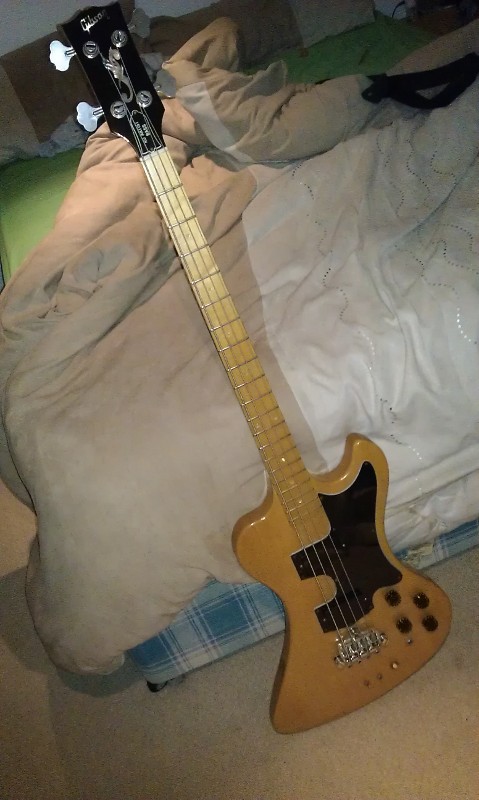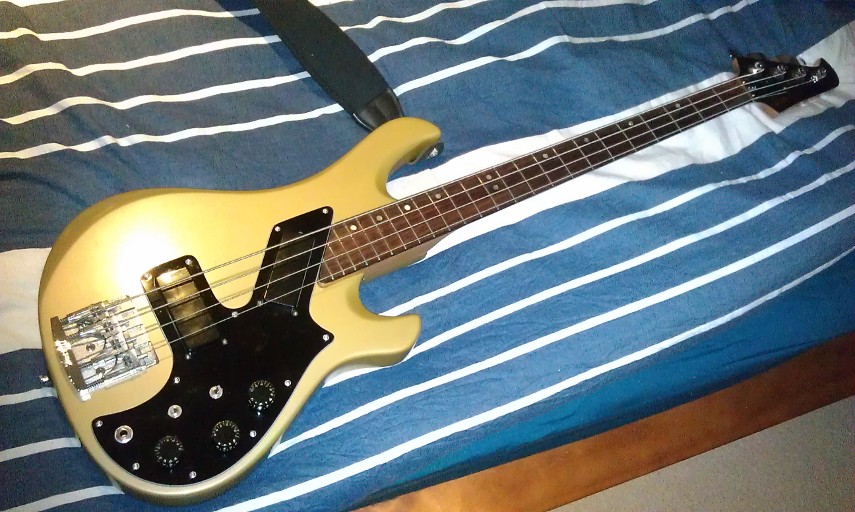-
Posts
9,554 -
Joined
-
Last visited
-
Days Won
15
Content Type
Profiles
Forums
Events
Shop
Articles
Posts posted by neepheid
-
-
[quote name='phatkat' timestamp='1330710214' post='1562080']
Just how many Aberdeen/N/E based bass players are there on here?
G...
[/quote]
A few that I know of. I can think of 6 off the top of my head, myself included. -
Reading all this makes me realise that I really don't have anything much to worry about, and certainly nothing to complain about. I can get slightly withdrawn (read: less chatty) before the gig (getting in the zone?) - it's worse if there's an unknown variable in the mix like it's an unfamiliar venue or I'm gigging a new bass for the first time. I loosen up with a single drink which I nurse until show time. Then I play, and if people afterwards are saying nice things to me then I'm learning to accept it and not listen to the little voice inside my head whispering that I've got away with it (that is: pulling the wool over everyone's eyes and pretending that I'm a bassist) for another gig.
That wasn't fishing for compliments by the way - I am under no illusion that after only 4 years of light gigging and a few months of lessons I still have a long way to go to even approach the levels of competency that I strive for (and see in the players I admire) - the little voice knows this and plays on it. -
I would also question why you deem it necessary to go to all this trouble. If it's just a vanity thing (and you may have other reasons - see below) then seriously, I wouldn't bother devaluing your bass in this way. While this might be the last bass you ever own, as your sig says you own three already then I would guess your GAS won't stop here and there will come a time when you want to sell it.
I've only done it once - but it was to remove the whole headstock finish rather than a specific requirement to get rid of the Squier logo. It was a silver headstock on a neck which would have looked great on the matching silver body but the body was ... blue. It really wasn't working for me so I removed all the finish from the front of the headstock. I sanded it down to the bare wood with appropriate grades of sandpaper. When I refinished, I masked off the edges and just re-lacquered the front face. Edges were a little rough feeling where the lacquer may have formed a slight ridge along the edge of the masking tape, but they were easily (but carefully) smoothed off. Being a bitsa bass, the whole devaluing thing had already been done quite some time ago
I should point out that I put a highly amusing "Fecker Imprecision Bass" logo on it, not a Fender one. No wool being pulled over anyone's eyes here. -
[quote name='apa' timestamp='1330864013' post='1563886']
Now this has been bugging me for quit some time. Being a designer / engineer its something that catches my eye so take a look at these pictures...............
...
They all have one thing in common which I consider ugly and old fashioned and while being emensly practical and functional it detracts from all that ergonomic and esthetic blood sweat and tears that goes into the design of these beautiful creatures.
Im talking about [b]THIS[/b]........................
Even when great lengths are taken to make something esthetic they plonk a thread and nut into it......
There are some designs out there, mostly for acoustic guitars like the ones that double are strap pins and this one........
But 99% of electric instruments that you buy from the £150 Squier Affinity to Mr Ritters £15,000 jobs they all have a thread and a nut stuck on them!!
And yes I understand the manufacturing practicalities of such things but its not rocket science to put a similar design to the Neutriks on them. Mr Ritter has no excuse!!
That is all. Have a good Sunday
A
[/quote]
At the risk of sounding like I'm at debate club at school...
Jack sockets don't bug me at all. To me, there's something comforting and reassuring about the familiarity of a tried and tested design. I don't find the nut/thread obtrusive in the slightest, it's not as if it's the size of a door knob is it? It's easy to fit, easy to adjust within acceptable tolerances and they're available just about anywhere should you need to source a replacement. I had to go to Dundee Maplin to get a replacement barrel jack for instance, because Aberdeen didn't stock them!
The pursuit of aesthetics (which is rarely objective in its nature) isn't a good reason to reinvent the wheel. What efficiency savings are we making here? Are barrel jacks easier to fit when it comes to assembly? No, not in my experience anyway. Are barrel jacks more sturdy? Perhaps physically, but when they fail repairs take longer and are more expensive (barrel jack sockets cost more to manufacture and therefore purchase and take longer to remove and replace). Also they're far too long to top load a guitar/bass with.
You say the nut/thread of the jack socket affects the ergonomics of the instrument. What makes it unergonomic? Do you hurt your hand on it? Is it difficult to insert the jack plug?
The jack socket is tried, tested, reliable and ubiquitous and as such, I'm a big fan of it. -
Are you sure there isn't a truss rod? Try looking in the soundhole at the heel of the neck?
-
I just like to play. It's particularly pleasing when everyone in the band is clicking together like Lego, be it an old song, a new song, a new arrangement of an old song, at rehearsals, recording or live performance, but when simply having a bass on me is pleasing to me, I'm easily pleased

I guess having played for only 4 years it's all still amazing to me. Ask me again in 10 years or so. -
Bump for the superbly constructed trolley

-
The Epiphone Thunderbird Pro has a latched battery door, so even if the battery did die at an unfortunate moment it would be a snap to change. Just remember to carry a spare if you go gigging with an active bass.
Most of my early active basses require a screwdriver to take a cover off in order to change the battery, so you've got nothing to worry about. They hadn't fully thought it out at that time
-
In theory, with two push pull pots you could make them on/off for each pickup (thus allowing one or the other or both (and technically a kill setting also)), then a single master volume and a single tone, but it's an awfully clunky way of doing things just to avoid stacked knobs. Are there no stack knobs which float your boat aesthetically?
Obviously you aren't going to get individual volumes so blending is out, it'll be all or nothing with something like the above. Not a problem for me (I like a switch me, can't stand all this "a little bit of jazz pickup mixed in" stuff - just make mine a P, a PJ or half a J )
) -
The "powers-that-be" are trying their best to squash music "piracy" and the "pirates" keep finding new ways to get around whatever measures the "powers-that-be" put in place. Is that an angle?
There has been recent legislation regarding licensing for small gigs, I'm sure there was a thread on here about it.
That's all I can think of quickly, I'm at work
-
There are two main sizes of concentric pot, measure the diameter of the fat and thin parts of the pot shaft.
Outer - 8mm Inner - 6mm
or
Outer - 6mm Inner - 3mm
Then go here and look for concentric knobs - [url="http://www.axesrus.com/axenob.htm#Knobs"]http://www.axesrus.com/axenob.htm#Knobs[/url] -
I put the fat part of a flatwound (Roto I think) string around the tuner once and it comprehensively failed with a big pop as it explosively unravelled.
-
I don't like it. I've seen bands that do this and what I don't like is sounds coming out at me which are not attributable to any action performed on an instrument on stage. The falseness of it irritates me.
Just a personal opinion, you decide
-
I generally have to buy my basses at distance due to my location so I usually don't have the luxury you are talking about. The only thing I absolutely require is that the neck must be suitably chunky (no less than 40mm at the nut and a generous amount of wood front to back).
Once I get it, it's new strings and a full setup. Then if it doesn't work out I sell it on. Time consuming process, but it does mean I get to play a fair few basses and seeing as the vast majority of purchases have been second hand I haven't lost much money in the process.
I've found a few keepers in the process, I'm happy with my lot
If I do ever get the chance to try before I buy then a lack of compliance in the strings is a big turn off for me. If the strings are a chore to press down then I won't enjoy my try-out and even though it could possibly be fixed with different strings it is highly unlikely that I will buy the bass on the basis of that first impression. -
Basses are inanimate objects, and therefore have no feelings. There's nothing to hurt, so own, fool around with and discard as you see fit

-
It's not worth 2 grand, fake or real. IMHO, of course

-
OBD
in Bass Guitars
I passed my first band audition with a red one of those

-


End of thread
-
I'd throw Billy Cox into the mix. Some of the stuff on First Rays of the New Rising Sun is very challenging indeed (to me anyway
 )
) -
[color=#3A3A3A][font=Tahoma,]I have recently upgraded my rig and so have for sale an Ashdown ABM 410T cab. This is a UK built ABM, 8 ohm impedance, 600W power handling. Three levels of tweeter (off, low, high) switchable at the rear. In good condition, only one chip out of the top edge of the cabinet. Comes with a home made trolley and a dust cover.[/font][/color]







[color=#3A3A3A][font=Tahoma,]I'd like £200 for this reliable and great sounding cab. I'm in Aberdeen, so will favour local(ish) customers within reasonable driving distance first but will post at cost if that doesn't work out. Locals are of course welcome to try it out.[/font][/color] -
[quote name='woodyratm' timestamp='1330431037' post='1557265']
Was that photo at a Panda eyes gig? Also Lemon Tree?
[/quote]
Correct on both points. -
In general I try to not look like someone has stepped out of the audience and picked up a random instrument. It's not a snobby thing, it's just I feel better having made a bit of an effort to look like I meant to get up there. Generally a shirt and tie, with a fondness for waistcoats.

Having said that, last gig was a polo shirt with lots of vaguely automotive patches on it (think someone going to a fancy dress party as a motor mechanic and overthinking it a little) and black jeans. I thought I'd tone it down a bit for the local rock dive bar
-
[quote name='mcnach' timestamp='1330350847' post='1555994']
I have read about the "OMG" setting... but what is it???
[/quote]
Ou7shined is the man to ask regarding this having studied it in great depth and replicated it in one of his basses, but basically it's applying a capacitor to the output from one of the coils of the MFD while leaving the other to come through unmodified. Don't ask me how but it results in a super bassy sound, like a bass boost and seems louder, which seems impossible considering all you're doing is taking away some of the treble frequencies from one of the coils, but that's what my ears are telling me! -
Do what you like. If you keep the original loom and it can be non-destructively removed and put back in afterwards if you decide to move the bass on then I don't see the problem. I presume you're going to keep the first two switches (pickup selector and series/parallel), so what you going to do with the last one? Passive safety valve? Kill switch? Just leave a dummy switch in? Replace it with a battery state LED? So many possibilities

I never use the "active" settings on my Tribute L-2000 - the treble boost sounds nasty to me and it's plenty loud as a passive instrument anyway. I've been thinking for a while now of making mine 100% passive and making it possible to switch between humbucker/OMG/single on both pickups.


.jpg.09f473c85e92973fcdd01badd0e6a34a.jpg)

Strap lock
in eBay - Weird and Wonderful
Posted
Yup, and he probably enjoyed very much the bottles of beer they came from